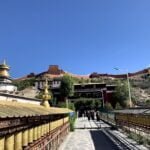Overview of San’an Qulin Temple
Location and Foundation: San’an Qulin Temple is situated in San’an Qulin Township, Longzi County, at an altitude of 3250 meters. The temple was founded in 1515 by the Living Buddha Pad-ma-rgyal-po, a native of Wolong, Kampo, and a follower of the Ba Kagyu sect.
Lineage of Living Buddhas: Following Pema Gabu, the temple has been led by seven generations of living Buddhas, including Basang Wangpo, Mipan Wangpo, Trile Xinda, Gongsekhe Lang, Yami Akiju, Mipanchowang, and Tenzin Kerao.
Architectural Layout and Features
Temple Buildings:
- Distribution and Orientation: The temple structures are aligned along the ridge in an east-west direction, facing south, and cover an area of about 3000 square meters (100 meters in length and 30 meters in width).
- Belief and Community: A Kagyu sect monastery, San’an Qulin Temple was home to over a thousand monks at its peak.
Dukang Hall: The Central Edifice
- Structure: The Dukang Hall is a two-story building, with the upper floor serving as a reception room and a warehouse. The ground floor comprises a sutra hall, a Buddhist hall, and other essential areas.
- Statues: The temple primarily enshrines statues of Sakyamuni Buddha and the eminent Kagyu Sect monk Zangpa Jianre.
Dharma Protector Temple:
- Construction: This newer addition to the temple complex is built with stone walls.
- Decorative Elements: The eaves of the walls are adorned with bianma grass and eight-treasure patterns, showcasing the temple’s artistic heritage.
Artistic and Cultural Significance
Mani Stone Carvings: San’an Qulin Temple is also known for its exquisite Mani stone carvings. These carvings, which bear high artistic value, are scattered throughout the temple grounds, adding to the site’s spiritual and cultural richness.
Conclusion
San’an Qulin Temple stands as a significant religious and historical site in Tibetan Buddhism, particularly within the Kagyu sect. Its lineage of living Buddhas, traditional architectural style, and the presence of artistic elements like Mani stone carvings make it a vital repository of Tibetan spiritual heritage and art. The temple’s enduring legacy continues to attract devotees and admirers of Buddhist culture and history.
















